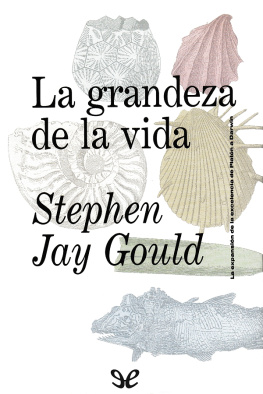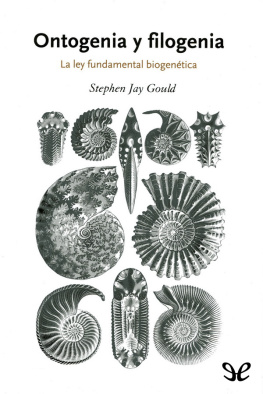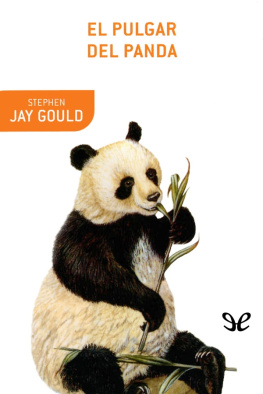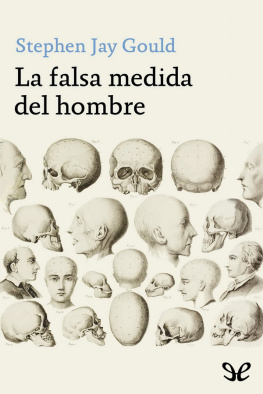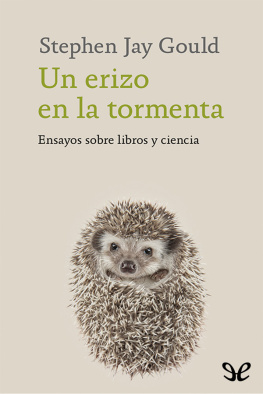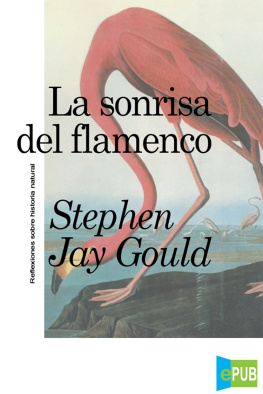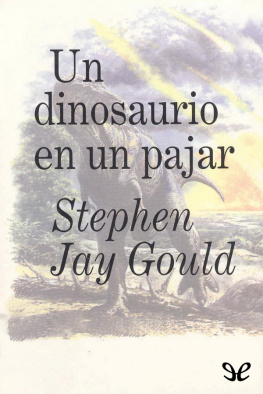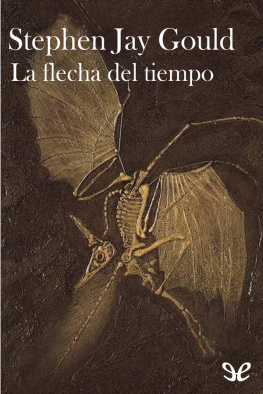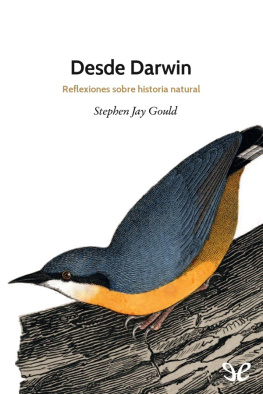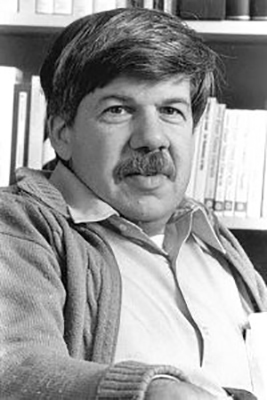
STEPHEN JAY GOULD (Nueva York, 1941 - 2002) fue un paleontólog, biólogo evolutivo, historiador de la ciencia y uno de los más influyentes y leídos divulgadores científicos de su generación. Gould pasó la mayor parte de su carrera docente en la Universidad de Harvard y trabajando en el Museo Americano de Historia Natural de Nueva York. En los últimos años de su vida, impartió clases de biología y evolución en la Universidad de Nueva York, cercana a su residencia en el SoHo.
La mayor contribución de Gould a la ciencia fue la teoría del equilibrio puntuado que desarrolló con Niles Eldredge en 1972. La teoría propone que la mayoría de los procesos evolutivos están compuestos por largos períodos de estabilidad, interrumpidos por episodios cortos y poco frecuentes de bifurcación evolutiva. La teoría contrasta con el gradualismo filogenético, la idea generalizada de que el cambio evolutivo se caracteriza por un patrón homogéneo y continuo. La mayor parte de la investigación empírica de Gould se basó en los géneros de caracoles terrestres Poecilozonites y Cerion y además contribuyó a la biología evolutiva del desarrollo. En su teoría evolutiva se opuso al seleccionismo estricto, la sociobiología aplicada a seres humanos y la psicología evolucionista. Hizo campaña contra el creacionismo y propuso que la ciencia y la religión sean considerados dos ámbitos distintos, o «magisterios», cuyas autoridades no se superponen (non overlapping magisteria).
Muchos de los ensayos de Gould para la revista Natural History fueron reimpresos en libros entre los que sobresalen Desde Darwin y El pulgar del panda. Sus tratados más populares incluyen libros como La falsa medida del hombre, La vida maravillosa y La grandeza de la vida. Poco tiempo antes de su muerte, Gould publicó un largo tratado recapitulando su versión de la teoría evolutiva moderna llamado La estructura de la teoría de la evolución (2002).
•
Bibliografía
Adams, D. (1981), «The probability of the league leader batting .400», Baseball Research Journal, pp. 82-83.
Arnold, A. J., D. C. Kelly y W. C. Parker (1995), «Causality Cope’s Rule: evidence from the planktonic Foraminifera», Journal of Paleontology, 69, pp. 203-210.
Augusta, J., y Z. Burian (1956), Prehistoric Animals, Spring Books, Londres.
Baross, J. A., M. D. Lilley y L. I. Gordon (1982), «Is the CH4, H2, and CO venting from submarine hydrothermal systems produced by thermophilic bacteria?», Nature, 298, pp. 366-368.
Baross, J. A., y J. W. Deming (1983), «Growth of “black smoker” bacteria at temperatures of at least 250 °C», Nature, 303, pp. 423-426.
Boyajian, G., y T. Lutz (1992), «Evolution of biological complexity and its relation to taxonomic longevity in the Ammonoide», Geology, 20, pp. 983-986.
Broad, W. J. (1993), «Strange new microbes hint at a vast subterranean world», The New York Times, 28 de diciembre, C1.
— (1994), «Drillers find lost world of ancient microbes», The New York Times, 4 de octubre, C1.
Brown, J. H., y B. A. Maurer (1986), «Body size, ecological dominance, and Cope’s rule», Nature, 324, pp. 248-250.
Carew, R., e I. Berkow (1979), Carew, Simon and Schuster, Nueva York.
Chatterjee, S., y M. Yilmaz (1991), «Parity in baseball: stability of evolving systems», manuscrito.
Chen J.-Y., J. H. Dzik, G. D. Edgecombe, L. Ramsköld y G.-Q. Zhoux (1995), «A possible early Cambrian chordate», Nature, 377, pp. 720-722.
Cope, E. D. (1896), The primary factors of organic Evolution, The Open Court Publishing Company, Chicago.
Curran, W. (1990), Big Sticks: The Batting Revolution of the Twenties, William Morrow and Company, Nueva York.
Dana, J. D. (1876), Manual of Geology, Ivison, Blakeman, Taylor and Company, Nueva York, 2.a edición.
Darwin, C. R. (1859), On the Origin of Species, John Murray, Londres (hay trad. cast.: El origen de las especies, Bruguera, Barcelona, 1980).
Durslag, M. (1975), «Why the 400 hitter is extinct», Baseball Digest, agosto, pp. 34-37.
Eckhardt, R. B., D. A. Eckhardt y J. T. Eckhardt (1988), «Are racehorses becoming faster?», Nature, 335, p. 773.
Eldredge, N., y S. J. Gould (1972), «Punctuated equilibria: An alternative to phyletic gradualism», en T. J. M. Schopf, ed., Models in Paleobiology, Freeman, Cooper & Company, San Francisco, pp. 82-115.
Fellows, J., P. Palmer y S. Mann (1989), «On the tendeney toward increasing specialization following the inception of a complex system — professional baseball 1871-1988», manuscrito.
Figuier, L. (1867), The World Before the Deluge, Chapman & Hall, Londres, nueva edición.
Fuhrman, J. A., K. McCallum y A. A. Davis (1992), «Novel major archaebaclerial group from marine plankton», Nature, 356, pp. 148-149.
Fuhrman, J. A., T. D. Sleeter, C. A. Carlson y L. M. Proctor (1989), «Dominance ol bacterial biomass in the Sargasso Sea and its ecological implications». Marine Ecology Progress Series, 57, pp. 207-217.
Gilovich, T., R. Vallone y A. Tversky (1985), «The hot hand in basketball: On the misperception of random sequences», Cognitive Psychology, 17, pp. 295-314.
Gingerich, P. D. (1981), «Variation, sexual dimorphism, and social structure in the early Eocene horse Hyracotherium (Mammalia, Perissodactyla)», Paleobiology, 7, 443-455.
Gold, T. (1992), «The deep, hot biosphere», Proceedings of the National Academy of Sciences USA, 89, pp. 6.045-6.049 .
Gould, S. J. (1983), «Losing the edge: the extinción of the 400 hitter», Vanity Fair, marzo, 120, pp. 264-278.
— (1985), «The median isn’t the message», Discover, junio, pp. 40-42.
— (1986), «Entropic homogeneity isn’t why no one hits 400 any more», Discover, agosto, pp. 60-66.
— (1987), «Life’s little joke; the evolutionary histories of horses and humans share a dubious distinction», Natural History, abril, pp. 16-25.
— (1988), «The case of the creeping fox terrier clone», NaturaI History, enero, pp. 16-24.
— (1988), «Trends as changes in variance: a new slant on progress and directionality in evolution», Journal of Paleontology, 62(3), pp. 319-329.
— (1988), «The Streak of Streaks», The New York Review of Books, 35, 18 de agosto, pp. 8-12.
— (1989), Wonderful Life: The Burgess Shale and the Nature of History, W. W. Norton, Nueva York (hay trad. cast.: La vida maravillosa: Burgess Shale y la naturaleza de la historia, Crítica, Barcelona, 1991).
— (1991), «The birth of the two-sex world. Review of Making sex: body and gender from the Greeks to Freud by Thomas Laqueur», The New York Review of Books, 38,13 de junio, pp. 11-13.
— (1993), «Prophet for the Earth. Review of The Diversity of Life by E. O. Wilson», Nature, 361, pp. 311-312.
— (1995), «Of it, not above it», Nature, 377, pp. 681-682.
— (1996), «Triumph of the root-heads». Natural History, enero, pp. 10-17.
— (1996), Dinosaur in a Haystack. Harmony Books, Nueva York (hay trad. cast.: Un dinosaurio en un pajar, Crítica, Barcelona, en prensa).
Gould, S. J., y N. Eldredge (1993), «Punctuated equilibrium comes of age», Nature, 366, pp. 223-227.
Gould, S. J., y R. C. Lewontin (1979), «The spandrels of San Marco and the Panglossian paradigm: A critique of the adaptationist programme», Proceeding of the Royal Society of London Series B, 205, pp. 581-598.
Gould, S. J., y E. S. Vrba (1982), «Exaptation — a missing term in the Science of form»,

